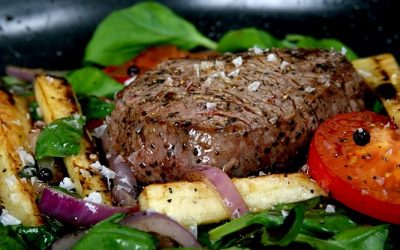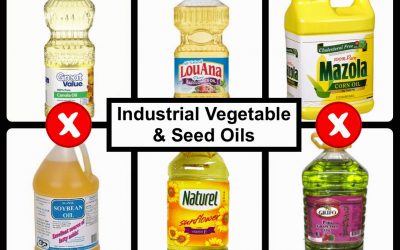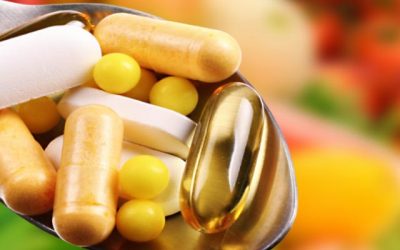Nutrition
Nutrition
Strategy: Eat Real Food!
GERD – How to avoid it for life!
In my mid 30s I started having indigestion with some foods. I read up on possible reasons for that and encountered the then surprising idea that production of hydrochloric acid (HCl) within the stomach declines with age! I learned that the stomach produces not only...
Maintaining Muscle Mass into Advanced Age Reduces All-cause Mortality
The study that triggered this article is titled "Mechanisms by which Calorie Restriction Delays the Onset of Sarcopenia", which I think misses the point entirely. The article points out that CR is very effective at life extension in short-lived species, but not nearly...
Reasons Not to Use Industrial Seed Oils – P. D. Mangan
Frank's Comment: P. D. is a health writer I subscribe to with great insights on staying healthy and fit long-term - read & heed! Vegetable oils are better termed industrial seed oils, since they're not made from vegetables and require an industrial process...
Protein Requirements for Optimal Aging
Study shows that Protein Requirements increase with age: When you see advise for protein intake in the popular press, numbers are all over the place, and there seems to be wide disagreement on amounts and sources. The popular position for aging seniors has long been...
At What Age Should We Start battling the Aging Process?
Well, I would call it the Age of Awareness - it's that first time we look in a mirror and realize things are a-changing for the worse. Usually it shows as a slow buildup of mid body fat for men - they haven't yet noticed loss of muscle, but it's happening. For the...
Here is a surprising (to me) outcome of a mouse gut biome study that increases longevity and lowers inflammation in aged mice. Surprising because the presence of gram-negative bacteria, which normally increase inflammation because they constantly shed their highly...
Training at Fitness19 in Simi Valley
In December I was hired as a trainer at the new Fitness19 Gym in Simi Valley CA. If you're tired of sliding down-hill toward infirmity, let me help you on a new path to strength and stamina with a renewed outlook on growing older with class and grace. I guide you...
The Difference: Grass-Fed vs Grain-Fed
The Health Benefits of Grass Farming Author: Jo Johnson “Why Grassfed is Best!” Consumers have been led to believe that meat is meat is meat. In other words, no matter what an animal is fed, the nutritional value of its products remains the same. This is not true. An...
Aging Optimally is Better Understood Today, With More and Better Tools to Help
It has been almost 7 years since I put up this website, and I find that today, the 6 Critical Keys to Senior Fitness still remain the most important aspects of living which need to be understood and attended to for maintaining excellent health into advanced age. We...
A Brief Wrap-up of 2011 for Senior Fitness
Here it is half-way through January, the decorations are back in storage, tax season is beginning, and it seems like the last thing I have time for is writing about health and aging well. But it has been a long time since I did a Frank's Column and the search engine...
Food, what we eat daily, provides the basic materials that build and sustain the body. But, the food we eat must really be food – REAL FOOD COMES WITHOUT AN INGREDIENT LIST!
We tend to think of our body as a self-contained object like a chair or maybe a car, and yes we need to input food and water or we get messed up, but the tendency is to think of oneself as the same today as we were yesterday. Nothing could be further from the truth. We are constantly tearing down and rebuilding every organ, cell and DNA molecule we possess. Even our bones are constantly replacing themselves. The material for all this renovation is food. Any deficiency in the needed materials, even short term, and our body will cleverly sacrifice one part to repair another; like scavenging muscle for protein to repair sunburned skin. But if a deficiency persists, some aspect of our physiology will break down and we become “diseased”.
The body is an amazingly complex system; its nutritional requirements are equally complex and yet humanity has been thriving on a wide range of regional diets for a long time. In most cases, primitive regional diets make the best of what is foods are available and the physical conditions that prevail, and for perhaps millions of years, have allowed us to reach reproductive age and live long enough to rear children to replace us. The current purpose, however, is to eat so well that we get all the nutrients we need to maximize our health and life span, and to avoid functional decline (and pain) as long as possible.
Strategies: Here are the basic principles for obtaining, digesting, absorbing and assimilating all the right nutrients:
Eat real, whole,unprocessed foods! Eat mostly that which is plucked from the ground, off a tree or bush, or was walking, swimming or flying recently. Eat almost nothing that comes in a bag or a box.
Our entire evolutionary history was spent eating foods described above. It makes immense sense to me that we evolved to prosper on such foods. We humans have recently rediscovered that the red and blue fruits are loaded with anti-oxidants, that the cabbage family vegetables are rich in cancer-fighting sulforaphanes. Do you know that grass-fed beef is high in omega-3 fats, and actually reduces inflammation like fish and fish oils?
Make baked goods (cakes, cookies, chips, crackers, desserts and white breads) a rare part of your diet.
Eat adequate amounts of the right fats! Fat is absolutely necessary for survival, but there are Fats that Heal and Fats that Kill.
That is the title of an amazing book by Udo Erasmus – a ‘must read’ for anyone interested in optimum health. If we don’t eat enough of the right fats, virtually every cell in every organ of our body will be compromised. Fats, however, require bile, produced by the liver and metered by the gallbladder, for digestion in the small intestines. Poor bile flow or an obstructed gallbladder will make digesting fats an uncomfortable task.
The liver manufactures approximately one quart of bile every day, which serves as a carrier for toxic substances to be effectively eliminated from the body. In addition, the bile emulsifies fats and fat-soluble vitamins in the intestine, improving their absorption. When the excretion of bile is inhibited (cholestasis), toxins stay in the liver longer with damaging effects. Many seniors have slow bile production, and need to be taking supplements (such as Milk Thistle and SAM-E) to enhance bile production.
We get one liver, and it has a huge number of critically important functions to perform for the duration of our lives. Its biggest enemies are High Fructose Corn Syrup (HFCS), refined seed oils, eating too frequently or too abundantly, acetaminophen (as in Tylenol and other off-shelf medicines)and statin drugs. Grass-fed livestock, free-range poultry and wild-caught fish have the proper balance of omega-3 and omega-6 fats and are health-building foods; grain-finished livestock, caged/commercially-fed poultry and farm-raised seafood do not, and are a large part of our health issues in this age.
Avoid all refined oils; use extra-virgin olive oil, extra-virgin coconut oil or butter/ghee for food and cooking. Eat or drink nothing that has the words ‘partially hydrogenated’ on the label.
Please read my article on hydrogenation to understand the gravity of what these fats do in your body, then get Erasmus’ book and fully understand the physiology of fats and their importance to your health. If you don’t eat enough fat, you will be unable to reduce your body-fat levels; your body will conserve stored fat if it gets too little in your diet. You can’t be lean, healthy, muscular and smart for life unless you eat enough of the right fats. Be aware of the common sources of hydrogenated oils and trans-fats; margarine, shortening, Cool Whip, non-dairy creamers, nearly all cocoa mixes, and the most popular of all – french fries and potato chips. Be aware that trans-fat content on labels is a fraudulent measure – the label can say zero trans-fats if the content is under 0.5 oz./per serving, so check the serving size (when was the last time you ate 9 chips as your “serving”?)
When you eat is every bit as important a what you eat.
This is the most important factor in avoiding ever-growing belly fat, metabolic syndrome and maintaining healthy liver function. The rules for proper liver function are these: Eat three meals (maximum) 5-6 hours apart to let insulin reach baseline levels between meals. Low insulin is required for the body to burn fats as fuel. Snacking at 3-4 hours completely shuts off the burning of fat for energy production. During the last three hours between meals the liver will supply blood sugar by breaking down fat deposits and converting the triglycerides to glucose and ketones. If the liver is working right, blood sugar will be maintained in a healthy range so we can run, jump and carry on normal physical activities without low blood sugar (hypoglycemia).
Similarly, eat nothing after dinner to get an 11-12 hour fast. This is the most important time for the liver to burn fats and detox the body. Eating before bed greatly hampers this process. When hunger comes between meals and after dinner, convince your brain that it is thirst arising and drink a big glass of water – the hunger will slack. Even better, make it ice water and the body will have to burn calories to heat it – water becomes a fat burner.
This issue revolves around the hormone Leptin, which is the primary regulator of metabolism. Frequent meals raises leptin levels in the bloodstream, chronically elevated leptin leads to leptin resistance, leptin resistance makes your brain think you are starving and drained of energy. You want to eat all the time and you want to eat lots of carbohydrates for fuel – this makes you pack on fat with abandon, and one day you are suddenly a type-II diabetic.
Learn sensible portion control! Modest portion size is a major part of eating correctly; never eat until you’re full. Eating only three (or less) modest meals a day is essential for fat control and muscle growth.
Most people over 45 have a protruding belly; the primary cause is eating three “solid” (meaning BIG) meals a day and snacking at every twinge of hunger. A very good gauge to portion size is that your protein serving (meat, fish, fowl or vegetarian) should be about the size of the palm of your hand. The rest of the meal should not exceed that weight in total. You can go some overboard on fibrous, non-starch vegetables, but small meals are the rule; shrink your stomach to fit in your abdominal cavity without a bulge. This one practice alone will reduce your blood sugar swings and slow the glycation mechanism of aging to a crawl.
Eat sufficient protein for the body to maintain and repair its structure! A healthy, active (intense weight training or aerobic sessions or sports 3 days per week) person needs about 1.5 grams of protein per pound of lean body mass to grow, repair and maintain muscle and other organs.
So, in these three meals, if each of them have palm-sized (your hand) meat courses or 2 -3 eggs, you will not be far from the right number. Make breakfast, in particular, a protein-rich meal to keep blood sugar from spiking and to give you the materials to repair your body throughout the day. Abandon sugar-filled breakfast cereals for real foods. The bulk of each meal should be non-starchy vegetables, with nuts, legumes or starch-based foods as a minor part. And, by-the-way, we now know that protein requirements to build muscle increase with age: Read More Here!
A protein drink after a workout will start the repair process and supply immediate amino acid needs. My practice is to use the recovery drink on those days as the meal, or add some real food soon after. Note that in natural sources, proteins and fats are nearly always found together. I try to imitate nature, and add a little flax oil, extra-virgin coconut oil or extra-virgin olive oil to my protein drinks for more complete nutrition.
Learn the rules of food combining! Basically, don’t eat starches and proteins together – they will stay in your stomach for hours and you won’t absorb the protein.
Many nutritionists will insist that you should eat a balance of protein, carbs and fats in every meal. I say try eating that next steak without the baked potato and see how much better you feel for the next three hours. For much easier digestion, cut way down on the starchy carbs and use a non-starch vegetable like asparagus or zucchini. If you find bean dishes hard to digest, take special note of the next strategy.
Supplement meals with Hydrochloric acid and digestive enzymes; take Probiotics.
Stomach acid and enzyme production decreases as we age – digestion worsens, absorption and assimilation of nutrients is less effective. Acid indigestion or heartburn is a clear sign that we are producing insufficient hydrochloric acid (HCl) and/or pepsin. It means food is staying in the stomach because it is not digesting. The problem is not too much acid, but too little. The media (and the medical community) will have you believe you need antacids or Prilosec to shut down acid production, but those strategies make proteins virtually indigestible and unavailable for assimilation. Long-term use of proton pump inhibitors is a guarantee of malnutrition!
Heartburn is usually a muscle problem. It involves the lower esophageal sphincter (LES). It’s a ring of muscle that relaxes or opens when food goes down into the stomach and squeezes shut when swallowing is complete. When it’s not being used, it’s supposed to stay shut. But, in the case of heartburn, your LES doesn’t seal completely. This allows stomach acids up into your esophagus. Over time this damages the esophageal lining, leading to inflammation, ulcers, and even cancer of the esophagus. Part of the “stay closed” signal requires sufficient stomach acid to get a strong response.
Take an HCl (Betaine HCl with Pepsin) capsule with any protein meal and see how much faster your meal digests, with no heartburn. There are many digestive enzyme formulations available that will make digestion a breeze. If you have frequent heartburn you are priming yourself for esophageal cancer. With properly sized meals, adequate meal spacing, supplemental HCl and digestive enzymes, you should overcome most digestive issues, and improve virtually all bodily functions as a result of increased nutrients available at the cellular level.
The next important aid to digestion is a source of friendly bacteria or Probiotics. If you have ever had a course of antibiotics, you have decimated the flora that should beneficially inhabit your digestive track. These bacteria, that we have evolved with symbiotically, are an important part of the digestive process, and create certain vitamins and enzymes for us. They play a vital role in our immune function. By their presence, they inhibit the overgrowth of harmful bacteria such as Salmonella and E-coli, fungi and parasites.
I have been the victim of food poisoning on several occasions, and am familiar with the progression of its symptoms. Immediately dosing with several probiotics capsules will normally stop it in its tracks. I always have them on hand, and at any sign of an upset stomach or intestinal stress, I pop two or three capsules and the problem subsides. My favorite brand these days is Swanson’s Epic Pro, which you can get from Swanson Health Products quite cheaply. For the most part these friendly bugs live beyond the stomach, but some bacteria such as H-pylori will bloom to dangerous and destructive levels unless the stomach is bathed in strong HCl frequently. Using antacids on a regular basis give these critters the advantage they need to infect the stomach lining and promote ulcers.
Add fermented foods to your diet to optimize your gut bacterial population.
Throughout human history the normal strategy for preserving food has been fermentation – most cultures have developed favorite foods based on letting the bacteria in the air modify foods to allow them to be stored. The bacteria ingested with these foods are the basis for maintaining the proper bacterial population in our digestive track. They are an important part of our immune system, and they make many nutrients, vitamins and signalling chemicals necessary for health and metabolic regulation. They are the primary source of vitamin K2, which marshals calcium and other minerals into bones and teeth and out of soft tissues like joint spaces, arteries and heart valves.
Vitamin K2 now appears to be a controlling factor in whether the liver makes small, dense lipoprotiens (VLDL, LDL, IDL, HDL and others) and whether we get heart disease or not. From milk we get cheeses, yoghurt, kifir. From vegetables we get sauerkraut, kimchi, natto, tempeh and others. From meats/fish we get several types of sausage and fish paste. Here is a link to a list of fermented foods from around the world. These foods are part of how humans have thrived for over a million years and we need to get them back in our diet.
Eat or drink almost nothing with sugar in it, refined or otherwise; give up sodas!
Chronic high blood sugar leads to insulin resistance and sustained levels of both blood glucose and insulin as seen in type II diabetes. Insulin itself is inflammation-promoting, and chronic high levels result in rapid aging of most body tissues. The worst offender these days is high fructose corn syrup (HFCS). It has been hyped in the past as very healthy because it doesn’t cause a rapid insulin response; but its high concentration of unbound fructose has to be mostly processed by the liver, pushing up triglyceride production – as much as 40% of which is immediately stored as fat, without the opportunity to be burned as fuel – avoid it entirely.
Another of the big offenders today is the boxed breakfast cereal; generally loaded with sugar and refined flour. Even the Granola types increase blood sugar too rapidly, and most are based on hydrogenated fats for shelf life. I haven’t eaten a manufactured breakfast cereal in two decades. I do eat plenty of free-range eggs, most often soft scrambled, with diced vegetables (green onions, peppers, capers, kalamata olives, radishes – pick your favorite) lightly sauteed in olive oil, butter/ghee and coconut oil; high in protein, fiber, good fats.
Another favorite is cottage cheese or goat-milk yogurt with diced fresh fruit or fresh berries stirred in. I add a little flax oil for omega-3 fats and top it with handful of crushed almonds, raw cacao nibs and chia seeds. I occasionally (cold mornings) use hot whole/multi-grain Muesli with some coconut/olive oil and butter tossed in for extra fat energy, but I generally limit my grain intake to keep blood sugar low.
Carbonated soft drinks are highly acidic, and raise blood acidity. The body responds by pulling calcium out of our bones to buffer/reduce the pH of the body’s fluids – not something you want happening to your bones. The sugar load from a soda is enormous; if I were looking for a single significant cause of obesity in children, I would site soft drinks as the number one culprit.
For decades we have been told that zero-calorie, artificially sweetened soft drinks were the healthy answer, but the data shows that those who drink sodas and teas sweetened with saccharin, aspartame and sucralose get just as fat if not fatter. Now we find that these chemicals shift our gut biome populations in ways that promotes insulin resistance and metabolic syndrome.
The same has not been shown for the herbal sweetener Stevia, which seems to actually have metabolic benefits. I suggest the time-proven approach – give them up and drink WATER. Avoid big glasses of any fruit juices; it is far better for your blood sugar levels to eat the fruit and drink pure water. It is important to avoid high-fructose corn syrup in anything. Fructose is processed by the liver directly, and roughly 40% of intake is immediately stored as body fat. High fructose intake has been shown to rapidly push us toward metabolic syndrome; avoid HFCS like it was a toxin – it is, for all practical purposes, a metabolic poison!
Be cautious and selective regarding grain-based food products! If you have signs of autoimmune diseases such as rheumatoid arthritis, irritable bowl syndrome or lupus, try eliminating all grains and grain products.
These principles fairly well sum up what I have learned about getting the right nutrients from the right foods, digested, absorbed and assimilated.
There is much more at the detail level to learn, but this is a very good start to eating right and getting the most out of it. I have mentioned a few supplements that enhance digestion, but the bulk of that topic can be found in our Supplements Category. I want to impress upon the reader that what you eat is the primary basis for your health, or lack-there-of. This information has been long coming to credibility, yet it is amazing to me that my grandmother was aware of most of it from a folk standpoint. One of my goals at Senior Fitness.com is to point our readers to credible sources of information, and to filter out the junk from the treasure. Don’t stop with a shallow understanding of health and fitness; make it your intent to be a life-long researcher of knowledge aimed at keeping your fitness at a peak level for the rest of your life.
We have thousands of words on this website to explain why these ideas are important, but if you begin to put these basic strategies into practice you will see major improvements in the way you look and feel.
We need to expand this topic further to discuss micronutrients – vitamins, minerals, trace elements, enzymes, coenzymes, metabolic co-factors and perhaps thousands of yet undiscovered compounds that perform undiscovered functions in life systems, and specifically how they impact the body’s operation, health and longevity. For now I want to point out that nearly all micronutrients arise from the soil in which our food, and the food of the animals we eat, is grown. Plants take all their nutrition from the soil, air, sun and water and build living structures capable of passing on life to following generations and to those who eat them.
Animals raised on plants grown in rich soils concentrate these life-giving elements in their bodies, and provide concentrated sources of nutrition for the carnivores and omnivores that eat them. Nowhere is this ‘food chain’ more obvious than in the sea, where nearly all of the multi-cell life forms eat smaller multi-cell life forms for most of the nutrients to support their life. Nearly all animal life on earth is sustained by eating raw plants or raw animals. The notable exception is Mankind. We cook our foods, for the most part, and damage many of the enzymes and co-factors in the process. We try to make up for soils that are wearing out and losses due to cooking by taking vitamins and mineral supplements. But therein lies the question: how well do our supplements make up for the nutrients missing in our foods? More to come!
You might gather from these strategies that this dietary regimen is very much in harmony with the Paleo Diet/Lifestyle. I urge you to look into the science supporting Paleo dietary strategies and adopt this approach to eating. Here is a well designed Paleo guide to get you eating for optimal health and fitness for life.
Another of my favorite authors (and websites) is Dr. Chris Kresser (chrisskresser.com). Here is a link to his best seller The Paleo Cure: Eat Right for Your Genes, Body Type, and Personal Health Needs — Prevent and Reverse Disease, Lose Weight Effortlessly, and Look and Feel Better than Ever.
Eat to Build Muscle – At any age we can build muscle, but an Anabolic diet that actually tastes good will be a fantastic help. Dave Ruel is a real bodybuilder who rewrote the book on eating for muscle growth – Gourmet meals that pack on muscle and burn fat: Learn how – Click Here!
If you have reached a point where you just don’t want to spend precious hours in your kitchen, or don’t have a kitchen, here is a healthy way to eat Real Food at home at a reasonable cost: sign up for Silver Cuisine from BistroMD:






